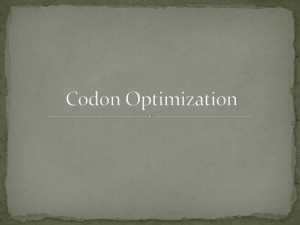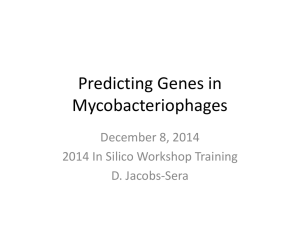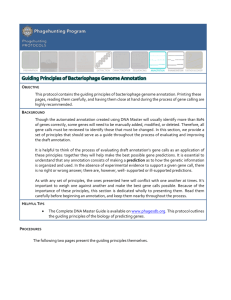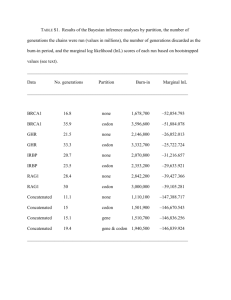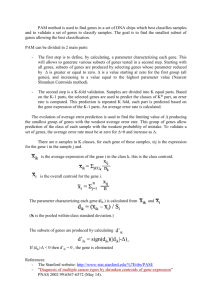gb-2014-15-3-r44-S1
advertisement
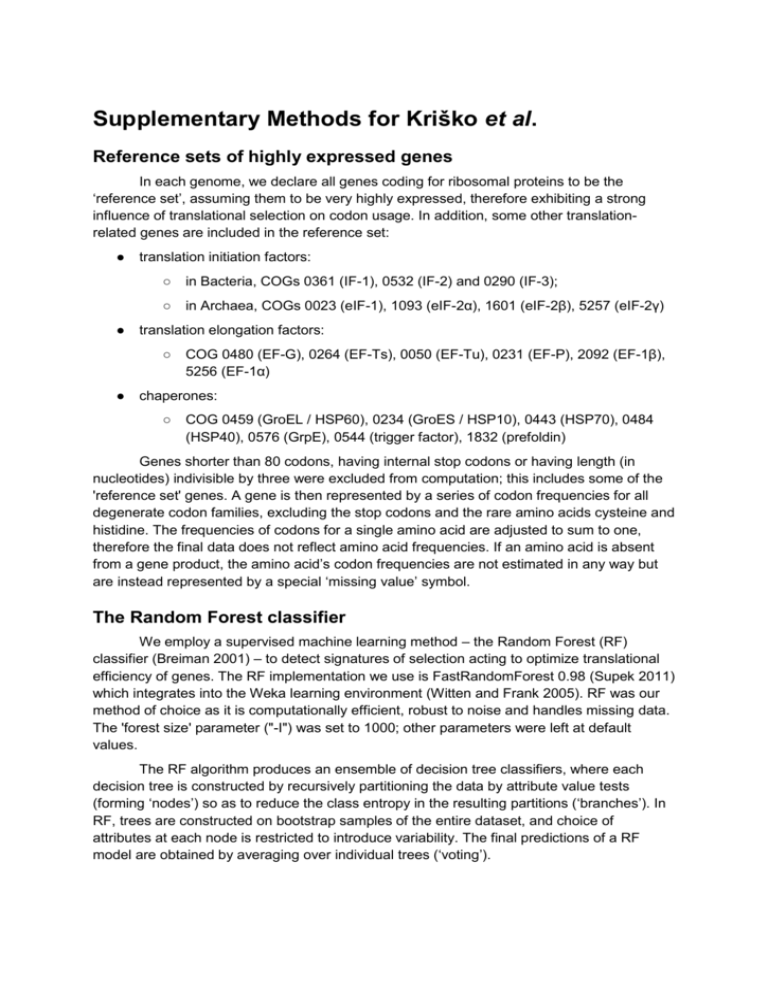
Supplementary Methods for Kriško et al.
Reference sets of highly expressed genes
In each genome, we declare all genes coding for ribosomal proteins to be the
‘reference set’, assuming them to be very highly expressed, therefore exhibiting a strong
influence of translational selection on codon usage. In addition, some other translationrelated genes are included in the reference set:
●
●
translation initiation factors:
○
in Bacteria, COGs 0361 (IF-1), 0532 (IF-2) and 0290 (IF-3);
○
in Archaea, COGs 0023 (eIF-1), 1093 (eIF-2α), 1601 (eIF-2β), 5257 (eIF-2γ)
translation elongation factors:
○
●
COG 0480 (EF-G), 0264 (EF-Ts), 0050 (EF-Tu), 0231 (EF-P), 2092 (EF-1β),
5256 (EF-1α)
chaperones:
○
COG 0459 (GroEL / HSP60), 0234 (GroES / HSP10), 0443 (HSP70), 0484
(HSP40), 0576 (GrpE), 0544 (trigger factor), 1832 (prefoldin)
Genes shorter than 80 codons, having internal stop codons or having length (in
nucleotides) indivisible by three were excluded from computation; this includes some of the
'reference set' genes. A gene is then represented by a series of codon frequencies for all
degenerate codon families, excluding the stop codons and the rare amino acids cysteine and
histidine. The frequencies of codons for a single amino acid are adjusted to sum to one,
therefore the final data does not reflect amino acid frequencies. If an amino acid is absent
from a gene product, the amino acid’s codon frequencies are not estimated in any way but
are instead represented by a special ‘missing value’ symbol.
The Random Forest classifier
We employ a supervised machine learning method – the Random Forest (RF)
classifier (Breiman 2001) – to detect signatures of selection acting to optimize translational
efficiency of genes. The RF implementation we use is FastRandomForest 0.98 (Supek 2011)
which integrates into the Weka learning environment (Witten and Frank 2005). RF was our
method of choice as it is computationally efficient, robust to noise and handles missing data.
The 'forest size' parameter ("-I") was set to 1000; other parameters were left at default
values.
The RF algorithm produces an ensemble of decision tree classifiers, where each
decision tree is constructed by recursively partitioning the data by attribute value tests
(forming ‘nodes’) so as to reduce the class entropy in the resulting partitions (‘branches’). In
RF, trees are constructed on bootstrap samples of the entire dataset, and choice of
attributes at each node is restricted to introduce variability. The final predictions of a RF
model are obtained by averaging over individual trees (‘voting’).
Detecting selection for translational efficiency in genomes
Nucleotide substitution patterns in DNA molecules influence codon frequencies of
genes; additionally, the biases in nucleotide substitution patterns may be region, strand, or
chromosome specific (Daubin and Perriere 2003, Rocha 2004). Thus, it is necessary to
control for the biases in order to reliably detect influence of translational selection on codon
biases.
We encode the information about local nucleotide substitution patterns affecting each
gene by computing mononucleotide and dinucleotide frequencies in the non-coding regions
of DNA neighboring the coding region of the gene. Genes for known functional RNA
molecules such as tRNA and rRNA are also treated as coding regions and thus do not
contribute toward mono- and di-nucleotide frequencies of intergenic DNA. Additionally, the
first 20 nt upstream of each coding region were masked and not taken into consideration
when sampling the ncDNA, as this region region of prokaryotic ncDNA was found to be
under much stronger selective pressures than the rest of the ncDNA (Molina and van
Nimwegen 2008). First 50 available (not masked) non-coding nucleotides upstream of the
start codon, together with the first 50 available nucleotides following the stop codon were
used as the ncDNA sample for each gene. We also tested wider ±100 and ±200 nt intervals;
see below.
To verify that translational selection acts in each genome - a prerequisite for
predicting gene expression from codon usage patterns - we employ the following procedure:
the RF classifier is first trained to distinguish the reference set genes based on the monoand di-nucleotide frequencies of genes’ neighboring non-coding DNA; the codon frequencies
are also supplied to the classifier at this point, but are shuffled between genes, thus
rendered uninformative. 100 runs of four-fold crossvalidation are used to estimate the
accuracy of the classifier using the area-under-ROC-curve (AUC) (Fawcett 2006) score, and
the AUC for each of the 100 runs of crossvalidation is recorded. The codon frequencies are
re-shuffled between genes in each run.
The procedure is then repeated for a second time, however now the true (unshuffled)
codon frequencies are included in the dataset for the RF classifier training. The AUC scores
are again recorded for each of the 100 runs of crossvalidation. To determine if selection for
translational efficiency acts on the genome as a whole, the sign test (McDonald 2008) is
used to compare 100 AUC scores obtained with shuffled codon frequencies to 100 AUC
scores obtained with true codon frequencies, for each genome. If the AUC score exhibits a
consistent increase over 100 runs of crossvalidation, the introduction of codon frequencies
improves the ability to discriminate the reference set genes, providing evidence that
translational selection acts on this specific genome. This was the case at P≤10-25 (sign test),
corresponding to FDR≤9·10-23, for all but one of the genomes, CandidatusHodgkinia
cicadicola Dsem , a highly reduced genome (<200 genes) with high GC content
(McCutcheon and Moran 2009) ; here, the difference of AUC scores was still significant at
P≤10-4(FDR=9.1%). Such a result agrees with the previous findings about selected codon
biases being universal among microbial genomes (Supek et al. 2010, Hershberg and Petrov
2009), indicating it is feasible to predict gene expression levels from codon usage in all of
the analyzed genomes.
Assigning 'highly expressed' labels to individual genes
In order to check whether each specific gene is affected by translational selection,
during the procedure described above which involves two rounds of RF classifier training,
the per-gene probabilities of belonging to the 'reference set' are recorded for each of the 100
runs of crossvalidation. The per-gene probabilities are then compared between the two
rounds of crossvalidation - the round with the shuffled vs. with the intact codon frequencies.
A sign test (McDonald 2008) is used to determine if an increase in probability occurs more
frequently than expected by chance; if it does, the gene is labeled as highly expressed. The
Supplementary Figure SM1 provides a schematic overview of the computational pipeline.
NCBI Entrez
Genomes
(n=921)
for each genome:
find codon
frequencies in
genes
find frequencies of mono- and
dinucleotides ('words') in non-coding DNA
(ncDNA) surrounding each gene
shuffled
codon freq. +
ncDNA word
frequencies
re-shuffle
codon freqs.
run RF classifier,
100 runs of 4-fold
crossvalidation
codon freq. +
ncDNA word
frequencies
reference
set* vs.
other genes
gene 1 probability
gene 2 probability
gene 3 probability
...
gene n probability
run RF classifier,
100 runs of 4-fold
crossvalidation
gene 1 probability
gene 2 probability
gene 3 probability
compare
...
gene n probability
use sign test to check if
probability of each being
classified as reference set*
decreases with randomization
of codon frequencies
highly expressed (HE) genes
Supplementary Methods Figure SM1. A schematic describing the computational workflow
employed to determine highly expressed (HE) genes in genomes.
We have set the sign test threshold P value to 10-15; this P corresponds to at least 88
out of 100 sign test ‘wins’ for the dataset with intact codon frequencies. Given that all
genomes analyzed had <104 genes, the used P value threshold corresponds to <10-11
false positive HE genes per genome. Also, given the smallest number of HE genes per
genome was 13 (for the Hodgkinia above), the highest possible FDR for detecting the
HE genes using the sign test is 10-11/13 ≈ 10-12.
This sign test P value should be regarded as somewhat liberal because the repeated
runs of crossvalidation are not independent, being based on repeated sampling from the
same set of genes. To obtain an additional, more conservative estimate, we employed a
corrected paired t-test (Nadeau and Bengio 2003) originally intended for comparison of
classification algorithms using repeated runs of crossvalidation. Note that we actually
compare RF models derived from a specific dataset, and not the different variants of the
underlying RF algorithm itself, and therefore this P value likely is pessimistic for our
experimental setup (Nadeau and Bengio 2003). For example, using this very conservative ttest, the median P value for highly expressed genes in the E. coli K-12 genome would be
5.6·10-4, while for 95% of the HE genes, P<0.04. For the Bacillus subtilis 168 genome, the
median of this conservative P value estimate for HE genes would be 5.6·10-4, while for 95%
of the HE genes P<0.07.
3
100
80
2
1
60
40
20
0
0
-log10 P value from
Mann-Whitney test
log2 ratio of average
expression of HE /
non-HE genes
The assignment of the HE/non-HE label to genes depends on a comparison – via the
described statistical test – of a gene’s codon usage to the dinucleotide composition of
neighboring non-coding DNA. As stated above, our analyses were performed with 50
upstream + 50 downstream nucleotides per gene (total 100nt). We also evaluated whether
taking neighborhoods of different sizes might have a bearing on the outcome by examining
the agreement of the HE labels to experimental gene expression data from NCBI GEO in 19
genomes (sources listed in section below). The results are summarized in the Figure SM2
below: taking wider intervals does not consistently improves either the ratio of average
HE/non-HE expression, or the P value of a Mann-Whitney test for separation in expression
levels between the HE and non-HE groups.
± 50nt (log2 HE/nonHE ratio)
± 100nt (log2 HE/nonHE ratio)
± 200nt (log2 HE/nonHE ratio)
± 50nt (-log10 M-W P val)
± 100nt (-log10 M-W P val)
± 200nt (-log10 M-W P val)
Supplementary Methods Figure SM2. Agreement of the HE/non-HE labels to gene
expression data in 19 bacterial genomes, depending on the width of the non-coding DNA
neighborhood that is used as a baseline. Order of the genomes same as in Fig 1C.
A comparison to the procedure from Supek et al. (PLOS Genetics
2010)
Note that the procedure described above is a derivative of the computational
workflow described in reference (Supek et al. 2010) with several changes that resulted in
better agreement to microarray measurements of gene expression in 19 phylogenetically
diverse bacteria; see below for the list of microarray datasets. The average ratio of
expression between the highly expressed genes and the rest of the genome has increased
from 2.4x to 3.9x; the P value for separation of the expression value in the two classes has
improved from 2·10-12 to 7·10-48 (Mann-Whitney test, median over 19 genomes); see Table
S1 for the full data. The changes to the algorithm encompass:
●
The original algorithm (Supek et al. 2010) uses 50 runs of 4-fold crossvalidation per
genome; here, 100 runs of 4-fold crossvalidation are used. This requires more
computational time but decreases the variability between repetitions of the pipeline.
●
Originally, the first (of the two) round of crossvalidation uses just mono- and dinucleotide frequencies, while the second uses both these, and the codon
frequencies; here, both sources of data are present in both rounds, but codon
frequencies are shuffled in the first round. This ensures that all comparisons are
made between classification models with an equal number of degrees of freedom.
The datasets have 75 features: this includes 55 codon frequencies (64, minus 3 stop
codons, 1 Met, 1 Trp, 2 Cys and 2 His codons), 16 dinucleotide and 4
mononucleotide frequencies.
●
The original reference set contained only ribosomal protein genes; here, the set is
expanded using translation factors and chaperones (see above). These genes were
typically used as parts of reference sets in previous studies, see eg. (Karlin and
Mrazek 2000), as they are considered to have strong translational codon usage
biases in various genomes.
●
Originally, all ncDNA in a fixed-size window around each gene is collected (10 kb
upstream of the start and 10 kb downstream of the stop codon); here, first 50 noncoding nt upstream of the start and first 50 non-coding nt downstream of the stop are
collected, regardless of the distance. This ensures each gene is represented with an
equal quantity of ncDNA.
●
Originally, all amino acids were considered. Here, the rare amino acids cysteine and
histidine are excluded as they were frequently present in very few instances or
completely absent from a gene, introducing noise.
●
Here, the Random Forest classifier is configured to put a heavier weight on the
minority class (this is always the reference set), equal to 1/proportion of reference set
genes. Originally, the two classes were treated with equal weights, despite the large
imbalance in their sizes.
Gene expression data sources
The datasets with absolute mRNA abundances in prokaryotes were downloaded
from the NCBI Gene Expression Omnibus (GEO). The mRNA abundance data was obtained
either using single-channel microarrays (commonly Affymetrix) or two-channel microarrays
normalized to genomic DNA. We have manually curated to list to include only datasets
where growth conditions can be expected to lead to fast growth of the organism, i.e. the
conditions where translational selection would be expected to act – exponential growth
phase, rich medium, and no physical, chemical or biological stress for the organism.
Depending on the growth conditions, the correlation of gene expression to codon usage
might be larger or smaller. Finally, we have reduced the list to one dataset per organism,
leaving us with 19 datasets with good coverage of various bacteria phyla: Proteobacteria (α,
ß, γ and δ), Firmicutes, Actinobacteria and the Thermus/Deinococcus clade. The list of
datasets is given below; the set includes four genomes where translational selection was
previously not detected in at least 2 out of 3 of the following studies (dos Reis et al. 2004,
Sharp et al. 2005, Carbone et al. 2005): Pseudomonas aeruginosa, Streptomyces coelicolor,
Mycobacterium tuberculosis and Nitrosomonas europaea.
List of mRNA expression datasets; the NCBI GEO Series ID is given (“GSExxxx”),
together with the GEO Samples (“GSMxxxx”) from the series that were averaged to obtain
final expression level. These sets contain absolute mRNA signal intensities, from singlechannel microarrays (commonly Affymetrix), except Streptomyces, Desulfovibrio and
Salmonella, which are from dual-channel microarrays normalized to genomic DNA.
Pseudomonas syringae tomato DC3000: GSE4848 (GSM109003, 109007, 109009, 109011, 109012,
109014)
Mycobacterium tuberculosis H37Rv: GSE7588 (GSM183531, 183633)
Nitrosomonas europaea: GSE10664 (GSM269650, 269651, 269652)
Streptococcus mutans: GSE6973 (GSM160647 – 160694)
Lactobacillus plantarum: GSE11383 (GSM287549, 287553, 287554, 287555, 287556, 287559)
Bacillus subtilis: GSE11937 (GSM299792, 299793, 299794, 299795)
Rhodopseudomonas palustris CGA009: GSE6221 (GSM143539, 143540, 143541, 143542, 143543,
143544)
Thermus thermophilus HB8: GSE10368 (GSM261559, 261569, 261594, 261560, 261570, 261595)
Bradyrhizobium japonicum: GSE12491 (GSM210242, 210243, 210244, 210245)
Desulfovibrio vulgaris Hildenborough: GSE4447 (GSM101160, 101161, 101162, 101166, 101167,
101168, 101325, 101326, 101330, 101331, 101332, 101333)
Haemophilus influenzae: GSE5061 (GSM114031, 114032, 114033)
Listeria monocytogenes: GSE3247 (GSM73161 – 73185)
Rhodobacter sphaeroides 2.4.1: GSE12269 (GSM308084 - 308107)
Staphylococcus aureus Mu50: GSE2728 (GSM52706, 52707, 52755, 52724, 52725, 52727, 52744,
52745, 52746)
Bifidobacterium longum: GSE5865 (GSM136748, 136749, 136750, 136751, 136752)
Streptomyces coelicolor: GSE7172 (GSM172822, 172823, 172826, 172830)
Escherichia coli K12: GSE13982 (GSM351280, 351282, 351295, 351297)
Salmonella typhimurium LT2: GSE4631 (GSM103442, 103443, 103444, 103445, 103450, 103757,
103758, 103759)
Pseudomonas aeruginosa: GSE4026 (GSM92178, 92179, 92182, 92183, 92186, 92187)
Normalization of experimental results
The measurements resulting from different experimental essays on E. coli mutants
were normalized to enable genes to be clustered based on their results across different
assays. Additionally, the normalization is meant to facilitate interpretability, where 0 means
'no effect' in all essays (same as wild-type), and 1 signifies a 'strong effect'. Values <0 or >1
are possible under certain conditions. The individual essays are normalized as follows:
●
protein carbonylation increase: optical density (OD) for each mutant was divided by
the OD for the wild-type, and 1 subtracted from the result
●
measuring ROS:
●
●
○
DHR-123 increase: fluorescence was divided by the fluorescence of the wildtype, and 1 subtracted from the result
○
CellROX increase: same as DHR-123 increase
measuring Fe:
○
cellular Fe increase: absorbance for each mutant was divided by the
absorbance for the wild-type, and 1 subtracted from the result
○
dipyridyl rescue: % survival of each mutant after H2O2 shock without dipyridyl
was subtracted from % survival of the same mutant after H2O2 shock with
dipyridyl, and the result divided by the % survival of the wild-type after H2O2
shock without dipyridyl
measuring NADPH:
○
cellular NADPH decrease: fluorescence for each mutant was divided by the
fluorescence for the wild-type, and this value subtracted from 1
○
NADPH rescue: same as dipyridyl rescue
Supplementary Methods References
Breiman L (2001) Random forests. Machine Learning 45: 5-32.
Carbone A, Kepes F, Zinovyev A (2005) Codon bias signatures, organization of
microorganisms in codon space, and lifestyle. Mol Biol Evol 22: 547-561.
Daubin V, Perriere G (2003) G+C3 structuring along the genome: a common feature in
prokaryotes. Mol Biol Evol 20: 471-483.
dos Reis M, Savva R, Wernisch L (2004) Solving the riddle of codon usage preferences: a
test for translational selection. Nucleic Acids Res 32: 5036-5044.
Fawcett T (2006) An introduction to ROC analysis. Pattern Recognition Letters 27: 861-874.
Hershberg R, Petrov DA (2009) General rules for optimal codon choice. PLoS Genet 5:
e1000556.
Karlin S, Mrazek J (2000) Predicted highly expressed genes of diverse prokaryotic genomes.
J Bacteriol 182: 5238-5250.
McCutcheon JP, McDonald BR, Moran NA (2009) Origin of an Alternative Genetic Code in
the Extremely Small and GC–Rich Genome of a Bacterial Symbiont. PLoS Genetics
5(7):e1000565.
McDonald JH (2008) Sign test. Handbook of Biological Statistics. Baltimore: Sparky House
Publishing. pp. 185-189.
Molina N, van Nimwegen E (2008) Universal patterns of purifying selection at noncoding
positions in bacteria. Genome Res 18: 148-160.
Nadeau C, Bengio Y (2003) Inference for the generalization error. Machine Learning 52:
239-281.
Rocha EP (2004) The replication-related organization of bacterial genomes. Microbiology
150: 1609-1627.
Sharp PM, Bailes E, Grocock RJ, Peden JF, Sockett RE (2005) Variation in the strength of
selected codon usage bias among bacteria. Nucleic Acids Res 33: 1141-1153.
Supek F (2011) The “Fast Random Forest” software. http://fast-randomforest.googlecode.com/
Supek F, Skunca N, Repar J, Vlahovicek K, Smuc T (2010) Translational selection is
ubiquitous in prokaryotes. PLoS Genet 6(6): e1001004.
Witten IH, Frank E (2005) Data Mining: Practical machine learning tools and techniques. San
Francisco: Morgan Kaufmann.

